
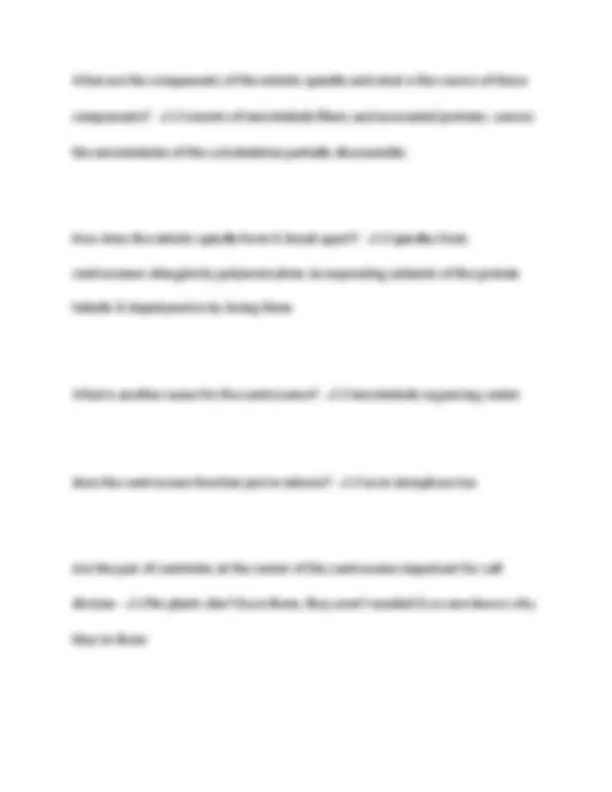
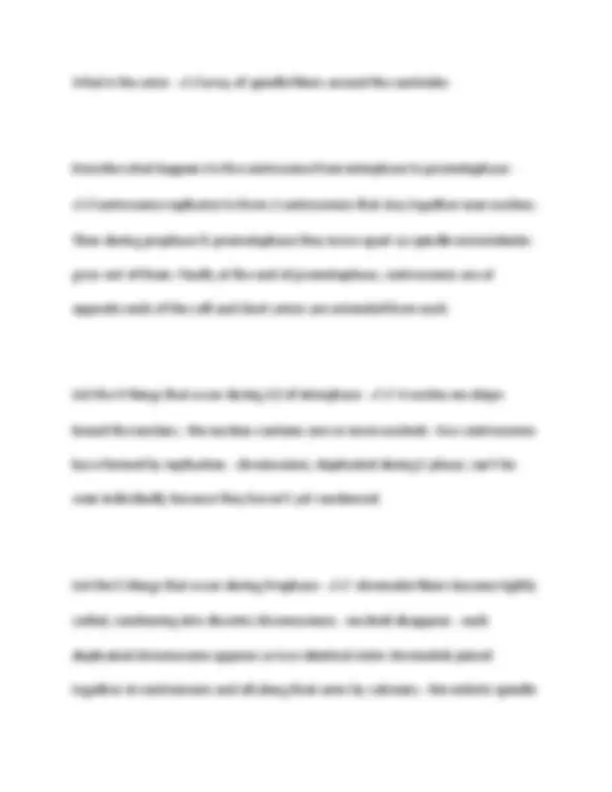
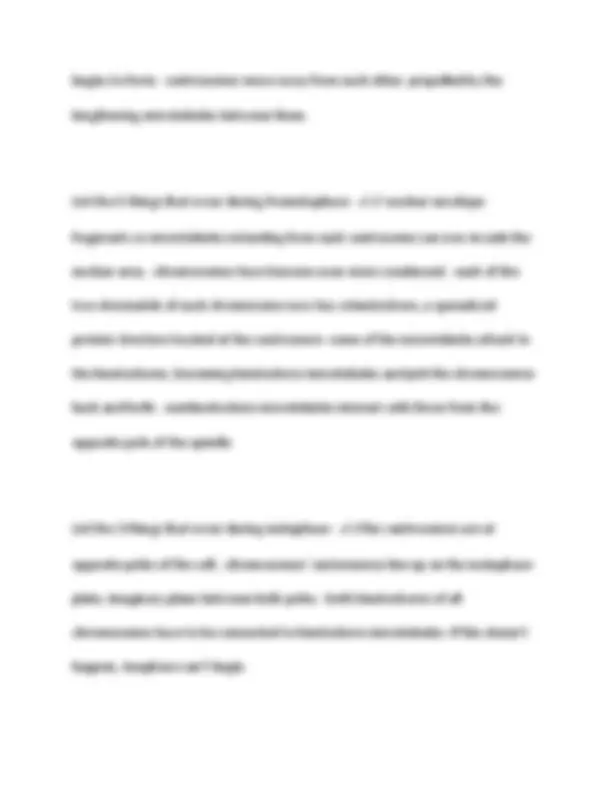
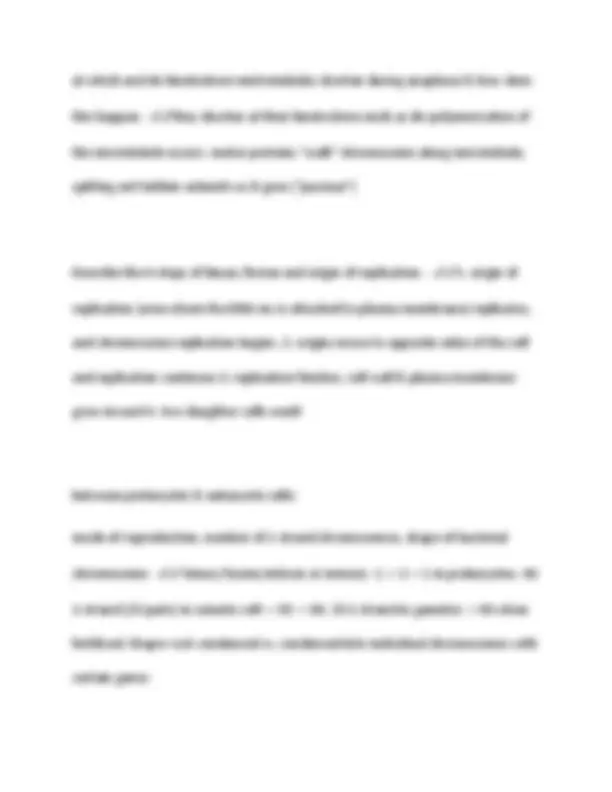
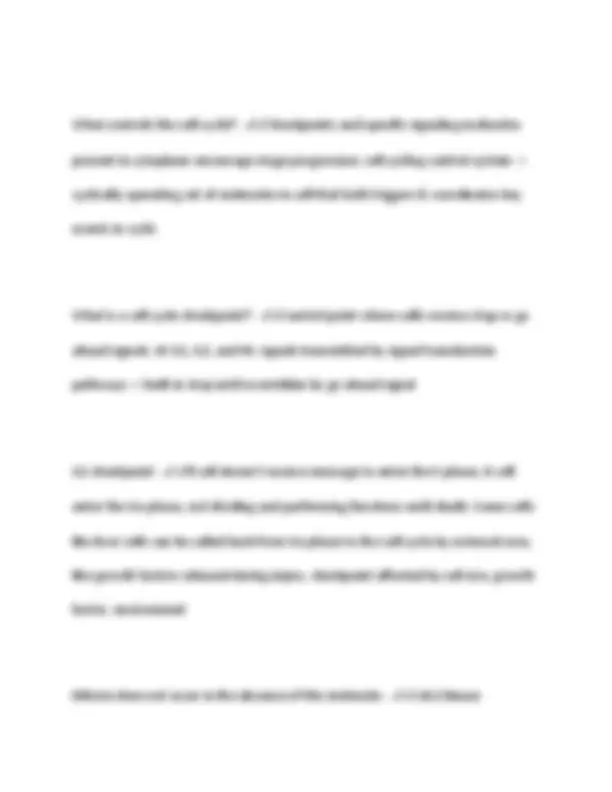
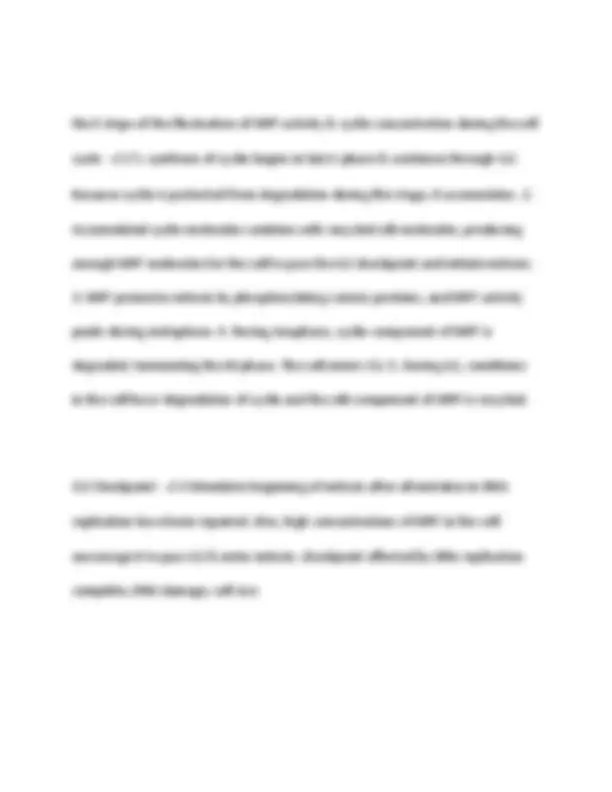
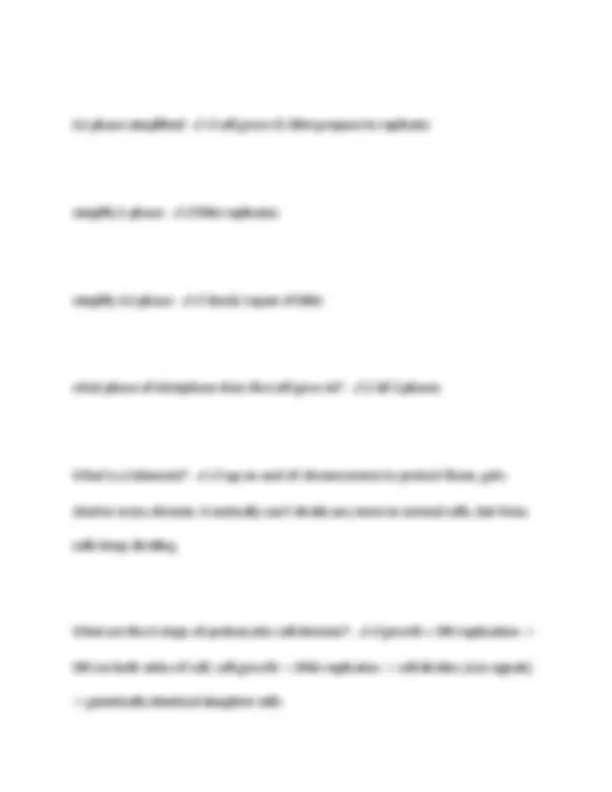
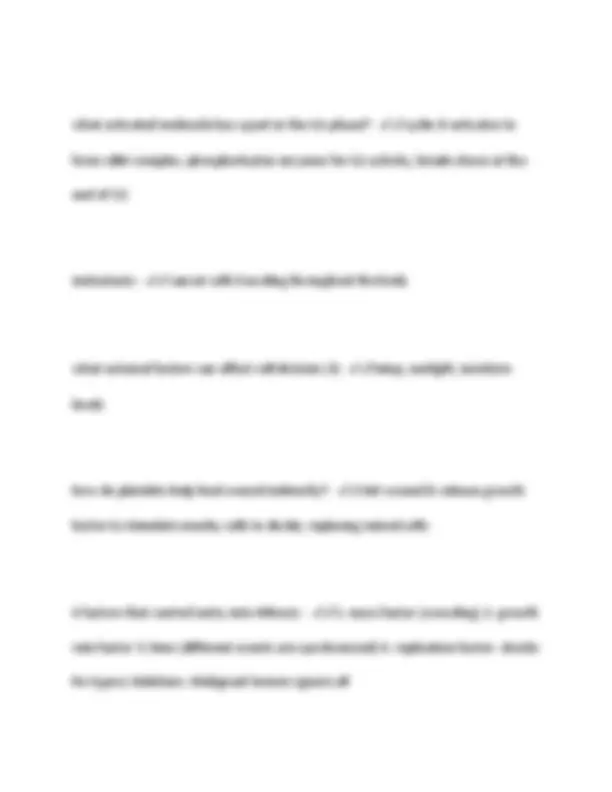
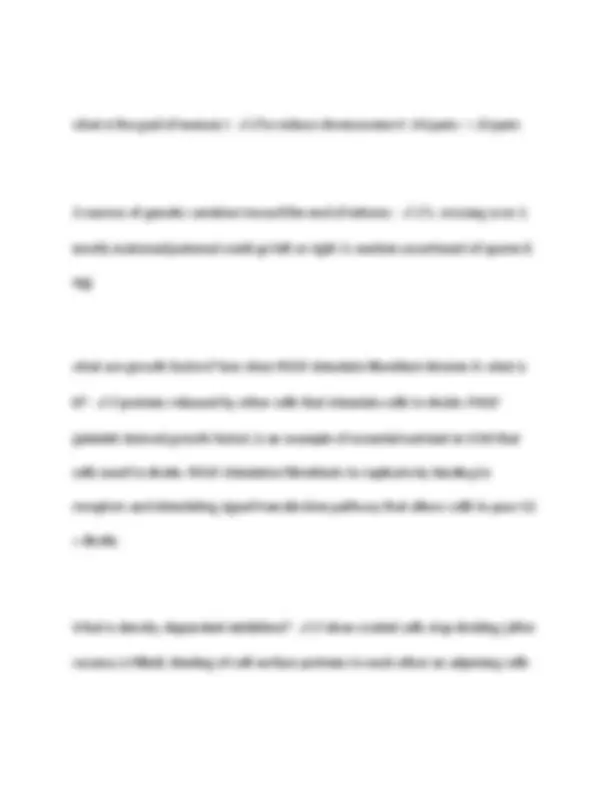
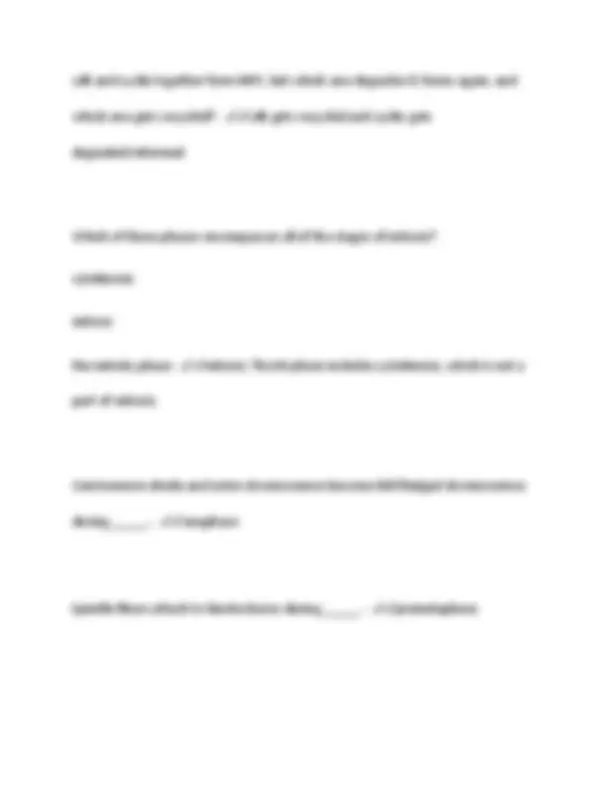


Study with the several resources on Docsity

Earn points by helping other students or get them with a premium plan


Prepare for your exams
Study with the several resources on Docsity

Earn points to download
Earn points by helping other students or get them with a premium plan
Community
Ask the community for help and clear up your study doubts
Discover the best universities in your country according to Docsity users
Free resources
Download our free guides on studying techniques, anxiety management strategies, and thesis advice from Docsity tutors
A comprehensive overview of the cell cycle, focusing on mitosis. It presents a series of questions and answers covering key concepts such as the roles of cell division, the stages of mitosis, the regulation of the cell cycle, and the differences between prokaryotic and eukaryotic cell division. Well-organized and provides detailed explanations, making it a valuable resource for students studying cell biology.
Typology: Exams
1 / 18

This page cannot be seen from the preview
Don't miss anything!











What are the three key roles of cell division? State each role and give an example
how many chromosomes are in a human somatic cell? - ✔✔ 46 How many single-strand chromosomes are in a cell after S phase - ✔✔ 92 chromatid: - ✔✔half of duplicated chromosome, genetically identical what is mitosis/ cytokinesis? - ✔✔division of the nucleus/ of the cytoplasm What occurs in meiosis & how is the chromosome # of daughter cells different? - ✔✔variation of cell division which yields nonidentical haploid daughter cells for cell division. Daughter cells have half the amount of chromosomes of the parent cell, but a mixture of traits from both parents.
What is the aster - ✔✔array of spindle fibers around the centrioles Describe what happens to the centrosome from interphase to prometaphase - ✔✔centrosome replicates to form 2 centrosomes that stay together near nucleus. Then during prophase & prometaphase they move apart as spindle microtubules grow out of them. Finally at the end of prometaphase, centrosomes are at opposite ends of the cell and short asters are extended from each. List the 4 things that occur during G2 of interphase - ✔✔-A nuclea envelope bound the nucleus. - the nucleus contains one or more nucleoli. - two centrosomes have formed by replication. - chromsomes, duplicated during S phase, can't be seen individually because they haven't yet condensed. List the 5 things that occur during Prophase - ✔✔-chromatin fibers become tightly coiled, condensing into discrete chromosomes. - nucleoli disappear. - each duplicated chromosome appears as two identical sister chromatids joined together at centromeres and all along their arms by cohesins. - the mitotic spindle
begins to form. - centrosomes move away from each other, propelled by the lengthening microtubules between them. List the 5 things that occur during Prometaphase - ✔✔-nuclear envelope fragments so microtubules extending from each centrosome can now invade the nuclear area. - chromosomes have become even more condensed. - each of the two chromatids of each chromosome now has a kinetochore, a specialized protein structure located at the centromere - some of the microtubules attach to the kinetochores, becoming kinetochore microtubules and jerk the chromosomes back and forth. - nonkinetochore microtubules interact with those from the opposite pole of the spindle List the 3 things that occur during metaphase - ✔✔the centrosomes are at opposite poles of the cell. - chromosomes' centromeres line up on the metaphase plate, imaginary plane between both poles. - both kinetochores of all chromosomes have to be connected to kinetochore microtubules. If this doesn't happen, Anaphase can't begin.
2 steps of cytokinesis in animal cells - ✔✔-division of cytoplasm is usually well underway by late telophase, so the two daughter cells appear shortly after the end of mitosis. - cleavage furrow (contractile ring of actin + myosin proteins) pinches the cell in two. how is the cell plate formed in plant cells - ✔✔vesicles from golgi apparatus containing cellulose move along microtubules to the center of the cell, coalesce, and form a cell plate. New cell wall materials (cellulose) fuse with cell membrane & old cell wall, forming a separation between the two new daughter cells. what is the function of nonkinetochore microtubules - ✔✔also called polar microtubules, extend & verlap each other from poles. When is the mitotic spindle complete? - ✔✔when mictrotubules of the aster are in contact with plasma membrane, and all kinetochores are attached
at which end do kinetochore mictrotubules shorten during anaphase & how does this happen - ✔✔they shorten at their kinetochore ends as de-polymerization of the microtubule occurs. motor proteins "walk" chromosome along microtubule, spitting out tubluin subunits as it goes ("pacman") Describe the 4 steps of binary fission and origin of replication. - ✔✔1. origin of replication (area where the DNA mc is attached to plasma membrane) replicates, and chromosome replication begins. 2. origins move to opposite sides of the cell and replication continues 3. replication finishes, cell wall & plasma membrane grow inward 4. two daughter cells result between prokaryotic & eukaryotic cells: mode of reproduction, number of 1-strand chromosomes, shape of bacterial chromosome - ✔✔-binary fission/mitosis or meiosis - 1 - > 2 - > 1 in prokaryotes. 46 1 - strand (23 pairs) in somatic cell - > 92 - > 46. 23 1-strand in gametes - > 46 when fertilized. Shape= not condensed vs. condensed into individual chromosomes with certain genes
the 5 steps of the fluctuation of MPF activity & cyclin concentration during the cell cycle - ✔✔1. synthesis of cyclin begins in late S phase & continues through G2. Because cyclin is protected from degradation during this stage, it accumulates. 2. Accumulated cyclin molecules combine with recycled cdk molecules, producing enough MPF molecules for the cell to pass the G2 checkpoint and initiate mitosis.
M checkpoint - ✔✔Anaphase won't begin until all the chromosomes are properly attached to the spindle at the metaphase plate and kinetochores are all attached. Then once regulatory protein is activated, it sets off the process of cleavage of cohesins. checkpoint affected by if spindle fibers are attached to kinetochores. What is a protein kinase? - ✔✔enzymes that activate or inactivate other proteins by phosphorylating them. Certain pk's give the go-ahead signals at the G1 & G checkpoints by attaching to cyclins and activating them. pk's are inactive in a growing cell. kinases drive the cell cycle, but they must be activated by attachment of a - ✔✔phosphate the activity of cyclin-dependent kinases rises and falls. Why? - ✔✔kinases must be attached to cyclins to be active, and only then can they drive the cell cycle. Highest activity at chekcpoints, cdk concentration rises & falls with cyclin concentration.
G1 phase simplified - ✔✔cell grows & DNA prepare to replicate simplify S phase - ✔✔DNA replicates simplify G2 phase - ✔✔check/ repair of DNA what phase of interphase does the cell grow in? - ✔✔all 3 phases What is a telomere? - ✔✔cap on end of chromosomes to protect them, gets shorter every division. Eventually can't divide any more in normal cells, but HeLa cells keep dividing What are the 4 steps of prokaryotic cell division? - ✔✔growth + ORI replication - > ORI on both sides of cell, cell growth - > DNA replicates - > cell divides (size signals)
genetically identical daughter cells
what activated molecule has a part in the G1 phase? - ✔✔cyclin D activates to form cdk4 complex, phosphorlyates enzymes for G1 activity, breaks down at the end of G metastasis: - ✔✔cancer cells traveling throughout the body what external factors can affect cell division (3) - ✔✔temp, sunlight, moisture levels how do platelets help heal wound indirectly? - ✔✔clot wound & release growth factor to stimulate nearby cells to divide, replacing ruined cells 4 factors that control entry into Mitosis: - ✔✔1. mass factor (crowding) 2. growth rate factor 3. time (different events are synchronized) 4. replication factor- checks for typos/ deletions. Malignant tumors ignore all
sends growth inhibiting signal to both cells, so they can't advance even if growth factor is present. what is anchorage dependence? - ✔✔to divide, cells must be attached to something- ECM or culture jar. Anchorage signals involve plasma membrane proteins what is transformation? - ✔✔process that converts normal cell to cancer cell. These are normally caught by the immune system, but otherwise it replicates & forms tumor. Benign tumor - ✔✔if abnormal cells remain at original site, can be removed by surgery. 4 things a malignant tumor could do/ could have - ✔✔-impair the functions of one or more organs - unusual #s of chromosomes